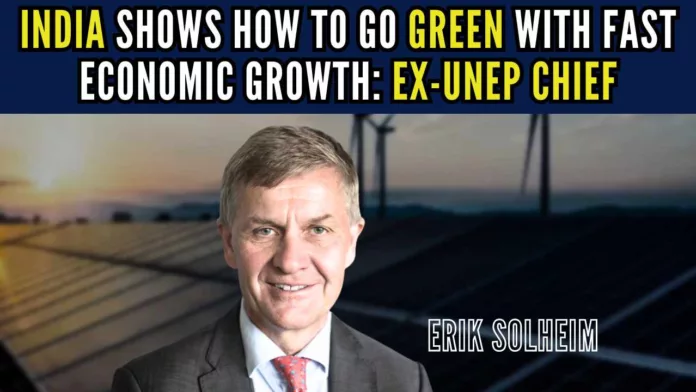
PM Modi’s Bharat has moved to the forefront of the struggle against climate change, environment protection: Ex-UNEP chief Erik Solheim
India showcases that “you can go green and provide fast economic growth at the same time”, feels former UN Environment Program executive director Erik Solheim.
In a telephonic interview with IANS as countries gear up to take stock of the progress on decarbonization, loss and damage finance, and more at the upcoming UN COP28 climate summit in Dubai, Solheim said Prime Minister Narendra Modi’s Bharat has moved to the forefront of the struggle against climate change and environment protection.
“Modi Ji has launched numerous green missions for India — focusing on green hydrogen, green batteries, electric cars, and more. The number of tigers in India has doubled over the last two decades. India showcases that you can go green and provide fast economic growth at the same time.”
Solheim, an experienced peace negotiator who has acted as the main facilitator of the peace process in Sri Lanka from 1998 to 2005, emphasizes the critical role that nature and biodiversity play in aiding mitigation and adaptation to global crises.
“Restoring nature is absolutely central to our climate efforts. Green landscapes protect us against climate disasters and absorb emissions. China is the world’s biggest tree-planting nation. But there is huge progress in India also.”
Madhya Pradesh Chief Minister Shivraj Singh Chouhan is planting one tree every day to inspire the people in his state. Telangana has increased its tree cover by seven percent. Tamil Nadu is progressing fast, creating new protected areas.
Solheim believes the twin crises of climate change and biodiversity loss have led to a rapidly growing focus on forest conservation and restoration.
“We need to mobilize both governments and business. Indonesia last year saw zero deforestation, a fantastic result in the world’s second biggest rainforest nation.”
This is thanks to good laws by the government as well as strong action from the big private sector companies in paper and palm oil, businesses like RGE, one of the world’s largest producers of wood pulp.
“Carbon finance and the carbon market need to reach small-scale farmers. This can only happen if the farmers form associations to jointly approach the big institutions. Andhra Pradesh is a great example of a state that has prioritized small-scale, green, and eco-friendly farming.”
“We need to bring the agendas of protecting Mother Earth and fighting pollution and emissions closer together. That will also create more engagement and inspiration.”
In the previous COPs there was inadequate climate and nature finance for developing countries, especially those whose ecosystems are most critical for climate.
“The developed world needs to step up and provide the finance they have promised. The US emission per capita up to now is 25 times higher than India’s. It’s obvious that the responsibility for causing the climate crisis rests with North America, Europe, and other developed nations. At the same time, developing nations such as China and India are the most likely to be successful.
[With Inputs from IANS]
PGurus is now on Telegram. Click here to join our channel and stay updated with all the latest news and views
For all the latest updates, download PGurus App.
- BJP drops 2-term sitting MP Poonam Mahajan; fields 26/11 counsel Ujjwal Nikam from Mumbai North Central - April 27, 2024
- RBI sets criteria for Small Finance Banks seeking Universal Banks license - April 27, 2024
- 16 Indian crew members on seized cargo ship to be released soon: Iran Foreign Minister - April 27, 2024










